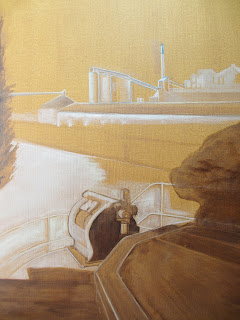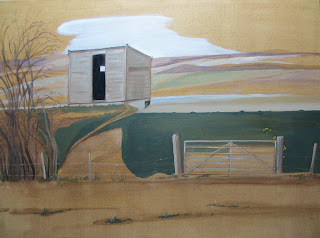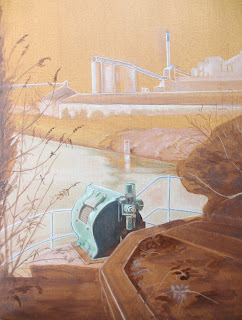My Studio
Initial Proposed Research Area
In my Presentation at the beginning of my MA course I described my initial proposed research area as follows:
"An exploration into the sense of place relating to people, industry and landscape - case study, South Ferriby and the River Ancholme".
I then spent time researching various relevant artists and writers and expanded my thoughts in a Written Proposal. I decided that my practical work would consist of a series of paintings and prints. This work has been supported since October, 2018 by my Blog:
Maggiesblog34.blogspot.com
As my practical work has progressed I have regularly used my Blog to review my work and update my Practice Statement to take account of my exploration into concepts through research and experimentation with techniques, materials and processes.
My updated Practice Statement reads as follows:
MAGGIE TAYLOR
PRACTICE STATEMENT:
“I AM INTERESTED IN HOW HUMAN
ACTIVITY RELATES TO AND INTERACTS WITH THE NATURAL LANDSCAPE.
INDUSTRY, HOUSING AND LEISURE IMPOSE THEMSELVES ONTO THE LANDSCAPE. NATURAL PHENOMENA IMPACT ON THE LAND AND THE
ENVIRONMENT IS UNDER THREAT FROM GLOBAL WARMING. MAN-MADE OBJECTS TAKE THEIR
PLACE ALONGSIDE NATURE, PLANTS AND TREES BLEND IN AND NATURE FINDS WAYS OF
FIGHTING BACK AND SURVIVING. THINGS LEFT BEHIND GET TAKEN OVER, GRASSES TAKE
ROOT IN PAVEMENTS, BUDDLEIA SPRING FROM CREVICES AND BRAMBLES ARCH OVER FENCES.
THESE CONCEPTS AND PROCESSES INFORM MY PRACTICE”.
May, 2019
Key points
Concepts
My ideas have progressed in a number of ways as a result of my continuing reading and other research.
I have expanded my thoughts to take account of the ways that human activity relates to and interacts with the natural landscape. So in effect I am looking at how human activity such as industry, housing and leisure physically impose themselves onto the landscape and relate to it. In my practical work I not only reflect on the visual impact and relationship of such things as industrial buildings, but also on the mood and atmosphere which such "interactions" cause.
This site has also alerted me to the dangerous threat to the site from natural phenomena and global warming. Great damage was done to the cement works, housing and the marina at the case study site in 2013, by a huge tidal flood and my work explores such phenomena. I have made a number of works which concentrate on the Humber Estuary, River Ancholme, tidal defences, and locks.
Details about my research feature strongly in my Blog, both into key academic reading, such as Schama S. (2004) Memory and Landscape and into relevant artists such as Michael Raedecker, Andrew Wyeth, George Shaw and Michael Landy.
Techniques and Processes
I have explored and experimented with a number of techniques and processes, both in my printing and painting practice.
Print Making
Techniques I have explored include dry point, etching, aquatint, screen printing, "open bite" etching, "sugar Lift" , chine colle and the mixing of techniques. Examples feature in my Blog and the results analysed.
I have also explored many different materials to work with, including steel, aluminium, Perspex, and zinc. After each set of works I have evaluated the results and learned from them.
Painting
As well as print making, my painting practice has significantly moved forward over recent months.
I have explored acrylic paint and oil paints, different grounds such as canvas boards and stretched canvases and new working methods. I have been greatly inspired by the artists I refer to above. I have developed my use of line, tone and colour in significant ways (see my Blog Posts "Painting (1), (2) and (3). My awareness of composition and negative space has increased and I have been able to create mood and atmosphere, which means that I am now speaking with my own personal voice.
Way Forward
My experiments have led me to discover new ideas and ways of working which I will continue to build on. I have already flagged up particularly successful pieces of work and methods in My Blog and how I can use what I have leaned in the future.
There is much yet to discover at my chosen site and over the coming months I intend to continue my artistic journey along the banks of the Humber Estuary, through the lock gates and into the River Ancholme. I will explore the marina and river banks and make my way up stream to Horkstow Bridge, a very early suspension bridge which is Grade II* listed. The historical importance of the Ferriby Sluice and Horkstow Bridge confirms the impact of the river to the local economy providing a means of drainage and commerce over many years.
This site has also alerted me to the dangerous threat to the site from natural phenomena and global warming. Great damage was done to the cement works, housing and the marina at the case study site in 2013, by a huge tidal flood and my work explores such phenomena. I have made a number of works which concentrate on the Humber Estuary, River Ancholme, tidal defences, and locks.
Details about my research feature strongly in my Blog, both into key academic reading, such as Schama S. (2004) Memory and Landscape and into relevant artists such as Michael Raedecker, Andrew Wyeth, George Shaw and Michael Landy.
Techniques and Processes
I have explored and experimented with a number of techniques and processes, both in my printing and painting practice.
Print Making
Techniques I have explored include dry point, etching, aquatint, screen printing, "open bite" etching, "sugar Lift" , chine colle and the mixing of techniques. Examples feature in my Blog and the results analysed.
I have also explored many different materials to work with, including steel, aluminium, Perspex, and zinc. After each set of works I have evaluated the results and learned from them.
Painting
As well as print making, my painting practice has significantly moved forward over recent months.
I have explored acrylic paint and oil paints, different grounds such as canvas boards and stretched canvases and new working methods. I have been greatly inspired by the artists I refer to above. I have developed my use of line, tone and colour in significant ways (see my Blog Posts "Painting (1), (2) and (3). My awareness of composition and negative space has increased and I have been able to create mood and atmosphere, which means that I am now speaking with my own personal voice.
Way Forward
My experiments have led me to discover new ideas and ways of working which I will continue to build on. I have already flagged up particularly successful pieces of work and methods in My Blog and how I can use what I have leaned in the future.
There is much yet to discover at my chosen site and over the coming months I intend to continue my artistic journey along the banks of the Humber Estuary, through the lock gates and into the River Ancholme. I will explore the marina and river banks and make my way up stream to Horkstow Bridge, a very early suspension bridge which is Grade II* listed. The historical importance of the Ferriby Sluice and Horkstow Bridge confirms the impact of the river to the local economy providing a means of drainage and commerce over many years.
My studio - work continues
Please see individual entries on my Blog for reference details.



































